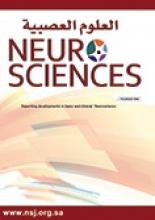Abstract
OBJECTIVE: To study the sociodemographic and clinical characteristics of possessive disorder in Jordan.
METHODS: This study was carried out prospectively at Prince Rashid Ben Al-Hassan Hospital, Irbid, Jordan between January 1997 and December 2000. It included all psychiatric patients who presented to the psychiatric outpatient clinic with a mono-symptom of being possessed or influenced by the Jinn, a total of 179 patients were studied.
RESULTS: Possessive disorder is more common among males (111) than females (68) with a male:female ratio of 1.6:1. With a mean age of 23.15 years and standard deviation of 6.93, the majority (82.1%) of patients were young of low educational attainment from rural areas (67.6%). The mean duration of illness was 24.61 months (standard deviation of 10.64) and the most common site of possession was head and neck (19.6%) followed by chest (11.7%) and upper limbs (11.7%). The most common mode of perception was somatic both visual and auditory (25.7%) and the most common behavioral changes induced by the possessing agent were loss of control (17.3%) followed by abnormal movement (16.6%), pseudo seizure (15.6%), loss of consciousness (14%) and change in tone of voice (14%). Sixty-eight (38%) of the patients had history of sexual intercourse with the possessing agent, more males (53) than females (15) had such experience. Two thirds of the patients had single possessing agent and almost all patients had been treated by native healers and about 2 thirds of the patients had reported psychosocial stresses prior to the onset of their illness.
CONCLUSION: Possessive disorder is a common condition in clinical practice that poses a diagnostic problem, it affects young males of low educational attainment from rural areas. Education and awareness is needed to prevent improper traditional therapy that may negatively affect the prognosis of this disorder.
- Copyright: © Neurosciences
Neurosciences is an Open Access journal and articles published are distributed under the terms of the Creative Commons Attribution-NonCommercial License (CC BY-NC). Readers may copy, distribute, and display the work for non-commercial purposes with the proper citation of the original work.






